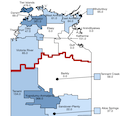Abstract
Background
The Northern Territory (NT) of Australia has a mix of climates, sparsely distributed population and a large proportion of the populace are Indigenous Australians, and influenza is known to have a disproportionate impact upon this group. Understanding the epidemiology of influenza in this region would inform public health strategies.
Objectives
To assess if there are consistent patterns in characteristics of influenza outbreaks in the NT.
Methods
Laboratory confirmed influenza cases in the NT are notified to the NT Centre for Disease Control. We conducted analyses on notified cases from 2007‐2016 to determine incidence rates (by age group, Indigenous status and area), seasonality of cases and spatial distribution of influenza types. Notified cases were linked to laboratory datasets to update information on influenza type or subtype
Results
The disparity in Indigenous and non‐Indigenous notification rates varied by age group, with rate ratios for Indigenous versus non‐Indigenous ranging from 1.58 (95% CI:1.39, 1.80) for ages 15‐24 to 5.56 (95% CI: 4.71, 6.57) for ages 55‐64. The disparity between Indigenous and non‐Indigenous notification rates appeared higher in the Central Australia region. Indigenous versus non‐Indigenous hospitalisation and mortality rate ratios were 6.51 (95% CI: 5.91, 7.18) and 5.46 (95% CI: 2.40, 12.71) respectively. Inter‐seasonal peaks during February and March occurred in 2011, 2013 and 2014, and were due to influenza activity in the tropical north of the NT.
Conclusions
Our results highlight the importance of influenza vaccination across all age groups for Indigenous Australians. An early vaccination campaign targeted against outbreaks in February‐March would be best focused on the tropical north.
